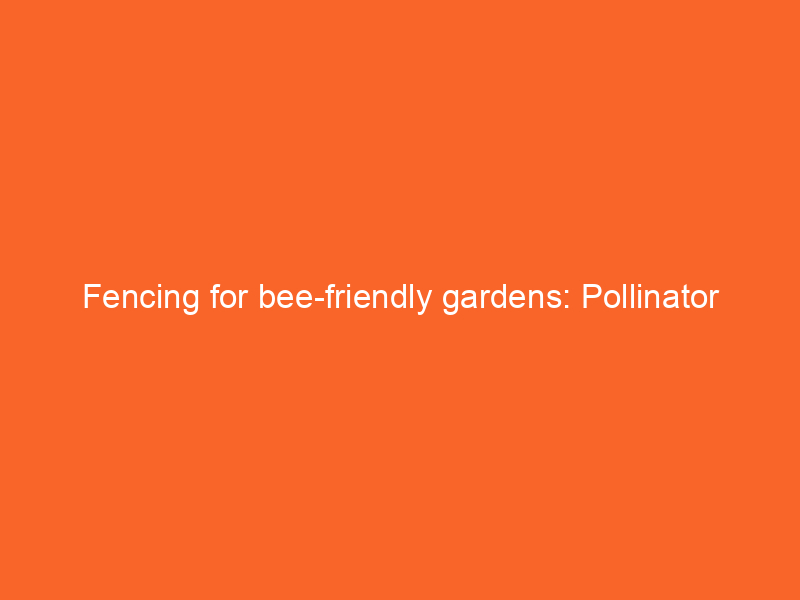In the heart of nature’s symphony, gardens support pollinators, especially our essential friends, the bees. At TimberLandry, where our commitment spans wood services and roofing throughout the UK, we invite you to explore the art of fencing for bee-friendly gardens and creating pollinator habitats. Join us in discovering how thoughtful fencing choices can not only define your outdoor space but also contribute to the well-being of these vital pollinators.
The Importance of Bee-Friendly Gardens
1. Understanding Pollinator Habitats
TimberLandry delves into the significance of pollinator habitats, focusing on the vital role bees play in pollinating plants. The blog explores the symbiotic relationship between plants and pollinators and emphasizes the impact of creating bee-friendly spaces to support declining bee populations.
2. Benefits of Bee-Friendly Gardens
Explore the benefits of bee-friendly gardens beyond pollination. TimberLandry discusses how these gardens contribute to biodiversity, ecosystem health, and the overall well-being of the environment. Discover the positive ripple effects that extend from your garden to the larger natural landscape.
Fencing Choices for Bee-Friendly Gardens
1. Wooden Fencing: A Natural Fit
TimberLandry recommends wooden fencing as a natural and aesthetically pleasing choice for bee-friendly gardens. The blog discusses different wood types, finishes, and styles that complement the garden’s natural elements while providing a functional enclosure.
2. Open Designs for Pollinator Movement
Delve into the concept of open fencing designs that facilitate the movement of pollinators. TimberLandry explores options like lattice fencing, picket fences, and horizontal slat designs that allow bees easy access to flowers while maintaining the defined boundaries of the garden.
Native Plants and Pollinator-Friendly Landscaping
1. Planting for Pollinators
TimberLandry guides on selecting native plants that attract and support pollinators. The blog explores the importance of diverse plant species, blooming seasons, and the integration of nectar-rich flowers to create a thriving ecosystem within the garden.
2. Creating a Bee Oasis with Landscaping
Discover how thoughtful landscaping choices can transform your garden into a bee oasis. TimberLandry discusses features like bee-friendly water sources, sheltered areas, and planting configurations that enhance the overall habitat for pollinators.
Designing Bee-Friendly Fences
1. Incorporating Bee Hotels and Nesting Sites
Explore the integration of bee hotels and nesting sites into your garden fencing. TimberLandry guides readers through the design and placement of these features, providing safe havens for solitary bees and enhancing the pollinator-friendly environment.
2. Colors and Finishes for Bee Attraction
The blog explores colors and finishes that attract bees to the garden. TimberLandry discusses how certain hues, particularly blues and purples, can visually appeal to bees. Additionally, it delves into finishes that enhance the natural beauty of wooden fences while remaining bee-friendly.
Sustainable Practices for Bee-Friendly Gardens
1. Avoiding Harmful Chemicals
TimberLandry emphasizes the importance of avoiding harmful chemicals in the garden. The blog discusses the negative impact of pesticides on pollinators and provides alternatives and sustainable practices for maintaining a healthy garden ecosystem.
2. Seasonal Garden Maintenance for Long-Term Bee Support
Explore seasonal garden maintenance practices that support pollinators year-round. TimberLandry provides a guide on pruning, weeding, and other tasks that contribute to a thriving garden habitat for bees.
Educating and Encouraging Community Participation
1. Promoting Bee Awareness in the Community
Discover how community participation contributes to creating a network of bee-friendly gardens. TimberLandry discusses educational initiatives, community events, and the importance of sharing knowledge to inspire others to create pollinator-friendly spaces.
2. Bee-Friendly Garden Certification Programs
The blog explores bee-friendly garden certification programs and initiatives in which homeowners and communities can participate. TimberLandry encourages readers to join these programs, contributing to a collective effort to create pollinator-friendly landscapes.
Conclusion
As you embark on the journey of creating a bee-friendly garden, TimberLandry stands as your guide. From choosing the right wooden fence to incorporating bee-friendly landscaping and sustainable practices, the blog unveils the intricate tapestry of supporting pollinators in your outdoor haven. Join us in the pursuit of creating vibrant, buzzing beauty within the confines of your garden—a sanctuary where the hum of bees becomes a melody of environmental harmony.
FAQs: Fencing for Bee-Friendly Gardens and Pollinator Habitats with TimberLandry
1. Why is it essential to create a bee-friendly garden, and how does fencing contribute to pollinator habitats?
Answer: The blog emphasizes the significance of bee-friendly gardens in supporting pollinators like bees. TimberLandry explains how thoughtful fencing choices contribute to the overall habitat, providing access to flowers, defining garden boundaries, and creating a safe pollinator space.
2. What fencing materials are recommended for bee-friendly gardens, and how do they align with the natural environment?
Answer: TimberLandry recommends wooden fencing for bee-friendly gardens, emphasizing its natural fit with the environment. The blog explores different wood types, finishes, and open designs that complement the garden’s aesthetic and facilitate pollinators’ movement.
3. How can homeowners design their fences to attract and support bees, including incorporating bee hotels and nesting sites?
Answer: TimberLandry guides homeowners in designing fences to attract and support bees by incorporating features like bee hotels and nesting sites. The blog provides insights into these features’ design, placement, and importance in creating a bee-friendly environment.
4. Are there specific landscaping practices and sustainable measures that homeowners can implement to enhance their bee-friendly gardens?
Answer: Yes, TimberLandry discusses landscaping practices and sustainable measures for bee-friendly gardens. The blog explores the selection of native plants, creating a bee oasis with landscaping features, avoiding harmful chemicals, and providing seasonal maintenance tips to ensure long-term bee support.
5. How can community participation play a role in promoting bee-friendly gardens, and are there certification programs available for homeowners?
Answer: TimberLandry highlights the importance of community participation in creating a network of bee-friendly gardens. The blog discusses educational initiatives, community events, and the significance of sharing knowledge. Additionally, it explores bee-friendly garden certification programs that homeowners and communities can participate in to contribute to the collective effort to support pollinators.

